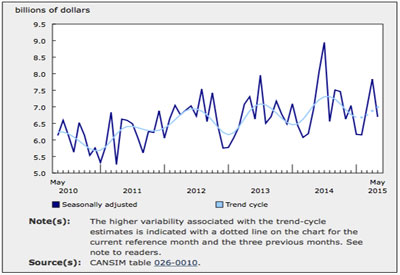Construction Growth Ahead: Proceed with Optimism

October 4, 2021
By: Swati Vora-Patel, Electro-Federation Canada
As a new year draws near and strategic plans roll out, business leaders everywhere are keeping a close watch on drivers that are setting up new baselines for market demand and opportunities. The pandemic has reset markets, lowering demand in core segments while opening the door to new and emerging areas.
At a recent EFC conference over 500 industry members participated in a two-day online forum to explore the pandemic’s impacts on four key areas affecting our industry: markets, customers, supply chains and employees. The conference featured 17 sessions that addressed trends in these core areas and profiled new opportunities that are cycling in to help members rebound and emerge stronger than before.
EFC presented its latest research report (“Covid-19 Impacts and Opportunities for the Canadian Electrical Industry”) which included, among other findings, an outlook on construction trends and mile markers that signal where the market spend might be as this industry moves beyond the pandemic. EFC also invited Alex Carrick from ConstructConnect (CanaData) to provide insights on construction forecasts in a post-pandemic era. The following is a summary of key insights:
New Construction Baselines
While the construction market has taken a significant hit during the past 18 months (Canadian construction starts are pegged at 1.7% this year), the market is expected to move towards steady recovery in 2022. This growth is expected to be largely driven by mega projects in these key segments:
Commercial: Although office building construction is not expected to reach pre-pandemic levels until 2025, data centre development is on the rise due to growing digital infrastructure requirements for remote work, online trading, entertainment streaming, 5G technology and artificial intelligence. According to CBRE, Canada has nearly 280 data centres operating, ranking fifth globally for data centre density. While some centres are new developments, many legacy printing facilities are being converted to support the growth of data centres. View this video to tour Canada’s largest data centre, which was once home to the Toronto Star facility in Vaughan, Ontario.
{youtube}fDHfvMF4BHQ{/youtube}
Institutional/Governmental: The outlook for new construction in this segment is robust. Hospital construction is expected to increase 64% in 2021 largely due to the aging population of Canadians. According to ConstructConnect, new hospital construction in 2020 and 2021 has grown more than eight-fold, year-over-year, due in part to large projects in Vancouver and Toronto. Advances in sustainability will also increase infrastructure spend in wind, solar and battery plant electrification to fulfill ‘greening’ goals for transportation, HVAC systems and liquefied natural gas (LNG) production.
Industrial: Canada has gained some growth in industrial construction from onshoring due to investments in production capacity and the increased automation of industrial processes. Further growth in this segment is attributed to distribution centre expansions and liquefied natural gas (LNG) projects.
- Distribution centres: Canada’s population density in cities and consumer expectations for real-time, on-demand access to products and services, are driving requirements for decentralized distribution and amplifying the need for ‘15-minute cities’
- LNG projects: according to the International Energy Agency, natural gas demand will return to pre-Covid levels, fueling the start of nearly 20 LNG projects that have been proposed in Canada: 13 in British Columbia, two in Quebec and three in Nova Scotia – with a total proposed export capacity of 216 million tons per annum (mtpa) of LNG. It’s estimated that the equivalent of 30 mtpa LNG exports from British Columbia could add nearly $7.4 billion to Canada’s annual economy over the next 30 years and raise national employment by an annual average of 65,000 jobs.
Residential: The pandemic has catapulted this segment to new heights! The housing market soared more than 50% above its long-term average of 200,000 units during the first half of 2021. While the residential market only accounts for 12% of the full electrical market mix (2021 Pathfinder Benchmarking Report), this segment will be an area for growth as homes continue to play a greater role in Canadians’ daily lives and will require ongoing adaptation to accommodate work-from-home areas and multi-use spaces.
For a comprehensive overview of these and other projections, download ConstructConnect’s Fall 2021 forecast report and visit https://www.constructconnect.com/economic-resources
The Silver Lining: New Market Opportunity
While this pandemic has taken a toll on businesses and the industry at large, it has also paved a path for new opportunities to allow leaders to assess and strategize evolving market needs to emerge stronger. Mega projects in commercial, institutional, industrial and residential markets will drive the construction industry forward and will continue to place reliance on electrical and automation equipment to support infrastructure development and health and safety protocols for physical distancing, sanitization and air quality. With construction growth on the horizon and new product requirements that allow safer work environments, it is time to renew strategies and proceed into the new year with optimism!
[1]https://www.constructconnect.com/hubfs/Starts%20and%20PIP%20Forecast%20Reports/2021%20Q2%20CC%20Construction%20Starts%20Forecast%20Report.pdf?bcs-agent-scanner=4f3e4207-817a-1f40-996d-c67f041c1ea2
[2] https://www.cbre.ca/en/about/media-center/toronto-is-north-americas-second-most-active-market-for-data-centre-leasing
[3] https://www.theglobeandmail.com/business/article-should-all-canadian-cities-be-15-minute-cities/
[5] https://canada.constructconnect.com/canadata/forecaster/economic/2021/04/who-knew-a-pandemic-would-lead-to-a-housing-boom











